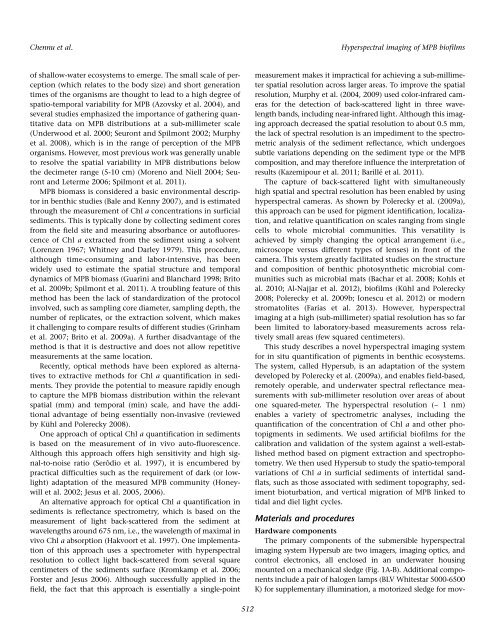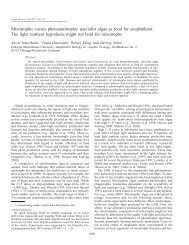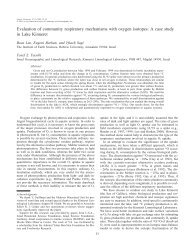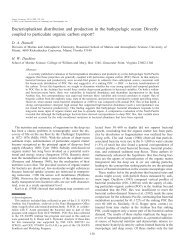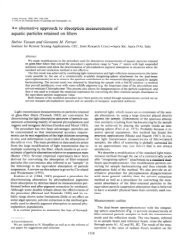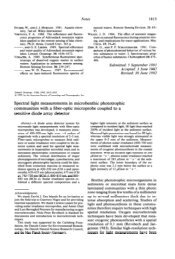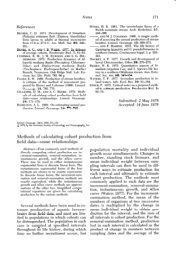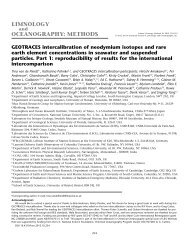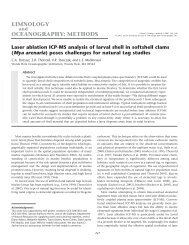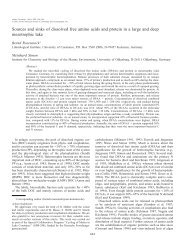Arjun Chennu, Paul Färber, Nils Volkenborn, Mohammad ... - ASLO
Arjun Chennu, Paul Färber, Nils Volkenborn, Mohammad ... - ASLO
Arjun Chennu, Paul Färber, Nils Volkenborn, Mohammad ... - ASLO
You also want an ePaper? Increase the reach of your titles
YUMPU automatically turns print PDFs into web optimized ePapers that Google loves.
<strong>Chennu</strong> et al.<br />
Hyperspectral imaging of MPB biofilms<br />
of shallow-water ecosystems to emerge. The small scale of perception<br />
(which relates to the body size) and short generation<br />
times of the organisms are thought to lead to a high degree of<br />
spatio-temporal variability for MPB (Azovsky et al. 2004), and<br />
several studies emphasized the importance of gathering quantitative<br />
data on MPB distributions at a sub-millimeter scale<br />
(Underwood et al. 2000; Seuront and Spilmont 2002; Murphy<br />
et al. 2008), which is in the range of perception of the MPB<br />
organisms. However, most previous work was generally unable<br />
to resolve the spatial variability in MPB distributions below<br />
the decimeter range (5-10 cm) (Moreno and Niell 2004; Seuront<br />
and Leterme 2006; Spilmont et al. 2011).<br />
MPB biomass is considered a basic environmental descriptor<br />
in benthic studies (Bale and Kenny 2007), and is estimated<br />
through the measurement of Chl a concentrations in surficial<br />
sediments. This is typically done by collecting sediment cores<br />
from the field site and measuring absorbance or autofluorescence<br />
of Chl a extracted from the sediment using a solvent<br />
(Lorenzen 1967; Whitney and Darley 1979). This procedure,<br />
although time-consuming and labor-intensive, has been<br />
widely used to estimate the spatial structure and temporal<br />
dynamics of MPB biomass (Guarini and Blanchard 1998; Brito<br />
et al. 2009b; Spilmont et al. 2011). A troubling feature of this<br />
method has been the lack of standardization of the protocol<br />
involved, such as sampling core diameter, sampling depth, the<br />
number of replicates, or the extraction solvent, which makes<br />
it challenging to compare results of different studies (Grinham<br />
et al. 2007; Brito et al. 2009a). A further disadvantage of the<br />
method is that it is destructive and does not allow repetitive<br />
measurements at the same location.<br />
Recently, optical methods have been explored as alternatives<br />
to extractive methods for Chl a quantification in sediments.<br />
They provide the potential to measure rapidly enough<br />
to capture the MPB biomass distribution within the relevant<br />
spatial (mm) and temporal (min) scale, and have the additional<br />
advantage of being essentially non-invasive (reviewed<br />
by Kühl and Polerecky 2008).<br />
One approach of optical Chl a quantification in sediments<br />
is based on the measurement of in vivo auto-fluorescence.<br />
Although this approach offers high sensitivity and high signal-to-noise<br />
ratio (Serôdio et al. 1997), it is encumbered by<br />
practical difficulties such as the requirement of dark (or lowlight)<br />
adaptation of the measured MPB community (Honeywill<br />
et al. 2002; Jesus et al. 2005, 2006).<br />
An alternative approach for optical Chl a quantification in<br />
sediments is reflectance spectrometry, which is based on the<br />
measurement of light back-scattered from the sediment at<br />
wavelengths around 675 nm, i.e., the wavelength of maximal in<br />
vivo Chl a absorption (Hakvoort et al. 1997). One implementation<br />
of this approach uses a spectrometer with hyperspectral<br />
resolution to collect light back-scattered from several square<br />
centimeters of the sediments surface (Kromkamp et al. 2006;<br />
Forster and Jesus 2006). Although successfully applied in the<br />
field, the fact that this approach is essentially a single-point<br />
measurement makes it impractical for achieving a sub-millimeter<br />
spatial resolution across larger areas. To improve the spatial<br />
resolution, Murphy et al. (2004, 2009) used color-infrared cameras<br />
for the detection of back-scattered light in three wavelength<br />
bands, including near-infrared light. Although this imaging<br />
approach decreased the spatial resolution to about 0.5 mm,<br />
the lack of spectral resolution is an impediment to the spectrometric<br />
analysis of the sediment reflectance, which undergoes<br />
subtle variations depending on the sediment type or the MPB<br />
composition, and may therefore influence the interpretation of<br />
results (Kazemipour et al. 2011; Barillé et al. 2011).<br />
The capture of back-scattered light with simultaneously<br />
high spatial and spectral resolution has been enabled by using<br />
hyperspectral cameras. As shown by Polerecky et al. (2009a),<br />
this approach can be used for pigment identification, localization,<br />
and relative quantification on scales ranging from single<br />
cells to whole microbial communities. This versatility is<br />
achieved by simply changing the optical arrangement (i.e.,<br />
microscope versus different types of lenses) in front of the<br />
camera. This system greatly facilitated studies on the structure<br />
and composition of benthic photosynthetic microbial communities<br />
such as microbial mats (Bachar et al. 2008; Kohls et<br />
al. 2010; Al-Najjar et al. 2012), biofilms (Kühl and Polerecky<br />
2008; Polerecky et al. 2009b; Ionescu et al. 2012) or modern<br />
stromatolites (Farías et al. 2013). However, hyperspectral<br />
imaging at a high (sub-millimeter) spatial resolution has so far<br />
been limited to laboratory-based measurements across relatively<br />
small areas (few squared centimeters).<br />
This study describes a novel hyperspectral imaging system<br />
for in situ quantification of pigments in benthic ecosystems.<br />
The system, called Hypersub, is an adaptation of the system<br />
developed by Polerecky et al. (2009a), and enables field-based,<br />
remotely operable, and underwater spectral reflectance measurements<br />
with sub-millimeter resolution over areas of about<br />
one squared-meter. The hyperspectral resolution (~ 1 nm)<br />
enables a variety of spectrometric analyses, including the<br />
quantification of the concentration of Chl a and other photopigments<br />
in sediments. We used artificial biofilms for the<br />
calibration and validation of the system against a well-established<br />
method based on pigment extraction and spectrophotometry.<br />
We then used Hypersub to study the spatio-temporal<br />
variations of Chl a in surficial sediments of intertidal sandflats,<br />
such as those associated with sediment topography, sediment<br />
bioturbation, and vertical migration of MPB linked to<br />
tidal and diel light cycles.<br />
Materials and procedures<br />
Hardware components<br />
The primary components of the submersible hyperspectral<br />
imaging system Hypersub are two imagers, imaging optics, and<br />
control electronics, all enclosed in an underwater housing<br />
mounted on a mechanical sledge (Fig. 1A-B). Additional components<br />
include a pair of halogen lamps (BLV Whitestar 5000-6500<br />
K) for supplementary illumination, a motorized sledge for mov-<br />
512


